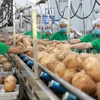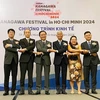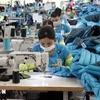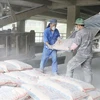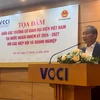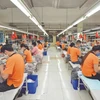Crop restructuring is one of the government’s agricultural restructuring key strategies, the Vietnam Economic News reported, adding that the Mekong River Delta is leading in switching from rice to other crops for higher economic efficiency, especially corn.
With the advantages such as fertile soil and moderate climate, the Mekong River Delta has long been the country’s key rice producing area. However, rice production and consumption faced export difficulties due to increasing competition with rivals from Thailand, India, and Myanmar, and rice farmer incomes have been lower than expected. Meanwhile, other agricultural crops such as corn and soybeans are potential alternatives due to severe shortages.
Switching from inefficient rice farming to other economically efficient crops such as corn farming is necessary for the Mekong River Delta in conformity with the governmentally approved agricultural restructuring project.
Some provinces like Dong Thap, An Giang, Tra Vinh, Soc Trang, and Long An have deployed corn farming models, with the intention of increasing the value added to agricultural products and farmer incomes.
The Corn Farming on Former Paddy Field in the Mekong River Delta project has been launched by the Institute of Agricultural Science for Southern Vietnam’s Agricultural Technology Research and Transfer Centre.
The project has initially achieved positive results in Long An. The entire 20 hectares of former paddy field in My Hanh Bac commune, Duc Hoa district, planted with NK7328, NK66, and NK67 corn varieties has proved promising. It is estimated that the corn yield per ha may reach about 8-10 tonnes, about double the former rice yield. With the current fresh corn purchase price per kg of 3,900 VND, corn farmers may gain from 9.4-17.2 million VND per ha, up 36 percent compared with rice gains after costs.
According to Director of the Long An’s Industry Promotion Centre (IPC) Nguyen Thanh Tung, corn, sesame and peanuts have been identified as good alternatives for the province, with corn being most important and farmed for the spring-summer crop. The Ecofarm JSC currently based in Duc Hoa district, Long An, will build a corn processing complex and be responsible for local corn purchases. The corn varieties provided by the Syngenta Co., Ltd for the model have proved adaptable to the local climate and high possible productivity.
In the coming years, Syngenta will strive to support the crop restructuring initiated by the government for inefficient rice farming areas to help farmers increase incomes, said Ngo Lanh, Solution Development Director of Syngenta Co., Ltd.-VNA
With the advantages such as fertile soil and moderate climate, the Mekong River Delta has long been the country’s key rice producing area. However, rice production and consumption faced export difficulties due to increasing competition with rivals from Thailand, India, and Myanmar, and rice farmer incomes have been lower than expected. Meanwhile, other agricultural crops such as corn and soybeans are potential alternatives due to severe shortages.
Switching from inefficient rice farming to other economically efficient crops such as corn farming is necessary for the Mekong River Delta in conformity with the governmentally approved agricultural restructuring project.
Some provinces like Dong Thap, An Giang, Tra Vinh, Soc Trang, and Long An have deployed corn farming models, with the intention of increasing the value added to agricultural products and farmer incomes.
The Corn Farming on Former Paddy Field in the Mekong River Delta project has been launched by the Institute of Agricultural Science for Southern Vietnam’s Agricultural Technology Research and Transfer Centre.
The project has initially achieved positive results in Long An. The entire 20 hectares of former paddy field in My Hanh Bac commune, Duc Hoa district, planted with NK7328, NK66, and NK67 corn varieties has proved promising. It is estimated that the corn yield per ha may reach about 8-10 tonnes, about double the former rice yield. With the current fresh corn purchase price per kg of 3,900 VND, corn farmers may gain from 9.4-17.2 million VND per ha, up 36 percent compared with rice gains after costs.
According to Director of the Long An’s Industry Promotion Centre (IPC) Nguyen Thanh Tung, corn, sesame and peanuts have been identified as good alternatives for the province, with corn being most important and farmed for the spring-summer crop. The Ecofarm JSC currently based in Duc Hoa district, Long An, will build a corn processing complex and be responsible for local corn purchases. The corn varieties provided by the Syngenta Co., Ltd for the model have proved adaptable to the local climate and high possible productivity.
In the coming years, Syngenta will strive to support the crop restructuring initiated by the government for inefficient rice farming areas to help farmers increase incomes, said Ngo Lanh, Solution Development Director of Syngenta Co., Ltd.-VNA







